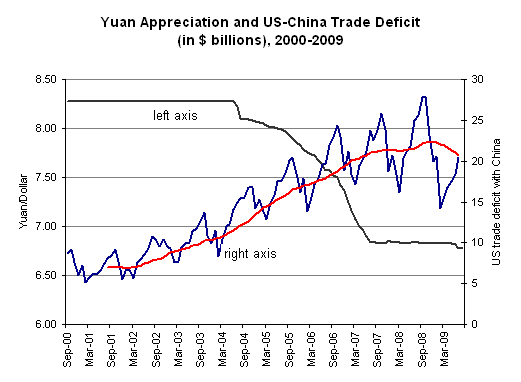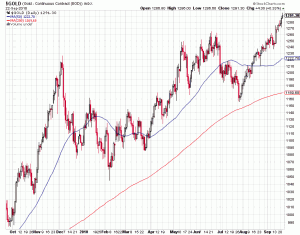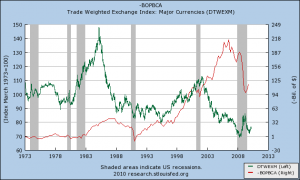Home » Currency
Category Archives: Currency
China’s new leadership
Cheng Li, an expert on factions within Chinese Communist Party, analyzes the new ‘balance’ of power. Unlike the previous generation of leaders, it seems that consensus will be reached more easily, as 6 out 7 of the members of the top decision-making body are from the same faction.
How much has Chinese Yuan really appreciated?
According to Economist Magazine, adding rising labor cost, Chinese Yuan has appreciated by nearly 50% against US dollar since 2005.
A real exchange rate takes account of price movements in each country. If prices rise faster in China than in America, China’s real exchange rate goes up, even if its nominal exchange rate stays the same. That’s because higher prices at home make China’s firms less competitive abroad, just as if their currency had gone up.To calculate the real exchange rate, you need a gauge of prices in each country. Many economists use the consumer-price index (CPI). But the CPI contains lots of goods and services (such as housing rents) that cannot be traded across borders.
Our measure of the real exchange rate, which we will regularly update, offers a more direct measure of competitiveness by looking instead at unit labour costs: the price of labour per widget. These costs go up when wages rise or productivity (widgets per worker) falls. In American manufacturing, unit labour costs have risen by less than 4% since the first quarter of 2005, according to the Bureau of Labour Statistics. In Chinese industry they have risen by 25% over that period, according to our sums.
George Soros on Chinese currency
(click to play; source: FT)
Here is the related FT article:
The prevailing exchange rate system is lopsided. China has essentially pegged its currency to the dollar while most other currencies fluctuate more or less freely. China has a two-tier system in which the capital account is strictly controlled; most other currencies don’t distinguish between current and capital accounts. This makes the Chinese currency chronically undervalued and assures China of a persistent large trade surplus.
It is no exaggeration to say that since the financial crisis, China has been in the driver’s seat. Its currency moves have had a decisive influence on exchange rates. Earlier this year when the euro got into trouble, China adopted a wait-and-see policy. Its absence as a buyer contributed to the euro’s decline. When the euro hit 120 against the dollar China stepped in to preserve the euro as an international currency. Chinese buying reversed the euro’s decline.
…
Whether it realises it or not, China has emerged as a leader of the world. If it fails to live up to the responsibilities of leadership, the global currency system is liable to break down and take the global economy with it. Either way, the Chinese trade surplus is bound to shrink but it would be much better for China if that happened as a result of rising living standards rather than a global economic decline.
Currency appreciation will not cure trade deficit
US House passed a currency bill by a wide margin, 348-79, yesterday to penalize China’s foreign-exchange practices. The measure would allow, but not require, the U.S. to levy tariffs on countries that undervalue their currencies, which makes their goods cheaper relative to American products.
This is a highly politically-charged bill, right before the US’ mid-term election. With high unemployment rate of nearly 10% at home, blaming foreigners for one’s own backyard problem has always been the easiest solution for politicians in the past.
As I have done many analysis before, currency is not the the solution to America’s trade deficit problem, Japan’s experience back in 1980s is the best example. Neither it’s the solution for the unemployment problem. The high unemployment rate was created by the most severe recession since WWII, and by the huge bubble in housing market.
Simple economics will tell when China’s exports become more expensive, US importers will, sooner or later, choose to import from other developing countries, whose exports will become cheaper and more competitive than China. This is the so-called substitution effect. In the end, China’s trade surplus will shrink with the US, but US’ overall trade deficit will not budge. To solve the trade deficit problem, US consumers really need to save more, or consume less. The savings rate has already been rapidly increasing in the past couple of years. Sounds painful, but this is a process the US economy has to go through. Yesterday’s spendthrift means today’s frugality.
And by the way, who will get hurt most by the import tariff? The US consumers.
What about China? China should stop subsidizing exports through lower currency or tax rebate. Subsidizing exports is essentially shifting Chinese tax payer’s money and put it into American consumers’ pockets. Good deal for America; bad deal for China. The export subsidy will also distort resources allocation according to price signals, resulting in too much capital invested in the low-end export industry, with poor capital return.
Here is the latest video analysis from WSJ (quite heated):
update1: 10 am 09/30
I said above Yuan’s appreciation will shrink US trade deficit with China, but US total trade balance with the world won’t change much because of substitution effect. Now looking at the the following two charts I’ve just made, I even doubt that Yuan’s appreciation will shrink US-China trade deficit.
The first chart shows the cumulative trade deficit of US with China (in red), and Yuan-Dollar exchange rate (in black) from 2000 to 2009. Yuan had depreciated by almost 17% from 2004 to 2007, but the US trade deficits with China just kept soaring. Yuan’s appreciation did not solve the problem.
The second graph shows a similar story. The difference with the first chart is now I show the monthly trade deficits (not cumulative, in red). The blue line shows the 12-month moving average of the monthly number. The trend was clearly upward despite Yuan’s 17% appreciation during 2004-2007. Again, currency appreciation did not solve the US trade deficit problem, and it just kept growing, only until the recent recession hit, it started to trend downward.
My educated guess is that, because Chinese price is so low, even with currency appreciation and higher goods prices than before, the demand for such goods did not decrease much. In other words, American consumers may have a quite inelastic demand curve for Chinese goods. After all, majority of Chinese exports are necessity goods, not the durables, nor the luxuries.
What’s behind Euro’s sharp rebound?
The biggest banks are unwinding their short positions against Euro. Whenever a large number of negative bets on a currency is closed, that currency climbs.
Some of the world’s most prestigious foreign-exchange banks are ripping up their gloomy forecasts for the rallying euro.Several of the top banks in the business are backtracking on their previously dire predictions for the single currency, most of which were formed when the European monetary union itself seemed in peril during April and May this year.
Some believe this is nothing new, a natural consequence of the market’s stabilization after an extraordinary run of events for major currencies this year. However, some industry veterans say that the market is now beholden to new forces that few if any market watchers yet fully understand.
…On Monday, Switzerland’s UBS AG —the world’s second-biggest bank in foreign exchange—tore up its forecast for the euro to be trading at $1.20 against the dollar in the next month. It now expects to see the currency at around $1.28—a 6% revision.
In a separate research note, the bank described the euro as “exasperating,” adding that the currency’s rally from under $1.19 in early June to over $1.30 by late July had “wrong-footed many in the currency market.”
Other banks caught off guard include Credit Suisse, another top-10 operation, which in late July upgraded its three-month forecast for the euro’s level against the dollar to $1.30 from $1.16, citing, in part, “a more rapid than anticipated recovery in euro-area policy credibility.”
BNP Paribas SA, whose analysts have held some of the gloomiest views of any in the market, took a similar step towards the end of July. “We still expect the euro to trade lower against the dollar, but the trough should be near $1.10 rather than $0.97,” the bank said.
European regulators’ stress tests on the region’s banks have played a big role. The generally upbeat results were roundly criticized when they were released July 23, but longer-term, the tests have rebuilt confidence in Europe’s financial sector and eased nerves over the euro area’s government bonds.
In addition, concerns that the U.S. may slip back into recession, and that the U.S. Federal Reserve may be drawn into further bond purchases to support the economy, took many in the market by surprise, and hit the dollar hard.
…
“We don’t often get extremes of pessimism like we had in April and May. It was dangerous,” said Marshall Gittler, a director and chief strategist at Deutsche Bank Suisse SA in Geneva, who has been watching the currencies market since 1998.
“We have gone from an Armageddon scenario, where some people thought the euro really might break up, to euphoria, or at least a return to normality, in a very short time,” he said.
…
Mr. Brown at Mitsubishi said that the sorts of hefty revisions banks are making now are a common part of the market’s rhythm. “My broad view is that it’s no harder to predict currency movements than it ever was,” he said.
Bergsten’s China action plan
Here is the action plan from C. Fred. Bergsten, Director of Peterson Institute of International Economics:
(Congressional Testimony) Hence I would recommend that the Administration adopt a new three-part strategy to promote early and substantial appreciation of the exchange rate of the renminbi
- Label China as a “currency manipulator” in its next foreign exchange report to the Congress on April 15 and, as required by law, then enter into negotiations with China to resolve the currency problem.
- Hopefully with the support of the European countries, and as many emerging market and developing economies as possible, seek a decision by the IMF (by a 51 percent majority of the weighted votes of member countries) to launch a “special” or “ad hoc” consultation to pursue Chinese agreement to remedy the situation promptly. If the consultation fails to produce results, the United States should ask the Executive Board to decide (by a 70 percent majority of the weighted votes) to publish a report criticizing China’s exchange rate policy.
- Hopefully with a similarly broad coalition, the United States should exercise its right to ask the WTO to constitute a dispute settlement panel to determine whether China has violated its obligations under Article XV (“frustration of the intent of the agreement by exchange action”) of the WTO charter and to recommend remedial action that other member countries could take in response. The WTO under its rules would ask the IMF whether the renminbi is undervalued, another reason why it is essential to engage the IMF centrally in the new initiative from the outse
Will currency depreciation solve the trade deficit problem?
The answer is plainly no. A depreciation of the US dollar will not remove the trade deficits. In 1970s, one dollar exchanged for 360 Japanese Yen. Now, one dollar is worth for only around 100 Yen. In other words, Yen has appreciated 72%. Still, Japan runs a huge trade surplus with the US today.
Exchange rate is just one of the many factors that drive the trade balance between two countries. Differences in interest rate, savings, growth rate, level of financial development (in terms of how easy to get access to consumer credit) all played a role.
Here I show a historical graph from St. Louis Fed, which looks at the relationship between trade-weighted dollar index (with major trading partners) and the US trade deficits. The green line is the dollar index (left axis), the higher the value, the more valuable the dollar. The red line is US trade deficits (right axis) in billions of dollars.
As shown in the graph, from mid 1980s to early 1990s, the dollar index dropped (or depreciation) against major currencies by over 40%, dropping from 150 to 85, and the trade deficits got eliminated.
During recent years, especially after 2002, the US dollar index declined from 110 to 70 (in 2008), another nearly 40% drop, however, the trade deficits soared. So there gotta be some other reasons that drive the trade balances.
How about the super easy monetary policy by the Greenspan Fed? The extended period of low interest rate after 9.11 helped fuel the housing bubble, creating a fake appreciation of household wealth…American consumers became more confident than ever, resulting in surge of consumption, and imports.
My conclusion is: currency is certainly a factor in determining trade balances, but it’s not all that matters. So don’t be fooled.
Finally, I wanted to entertain you with another piece of debate on the issue.








